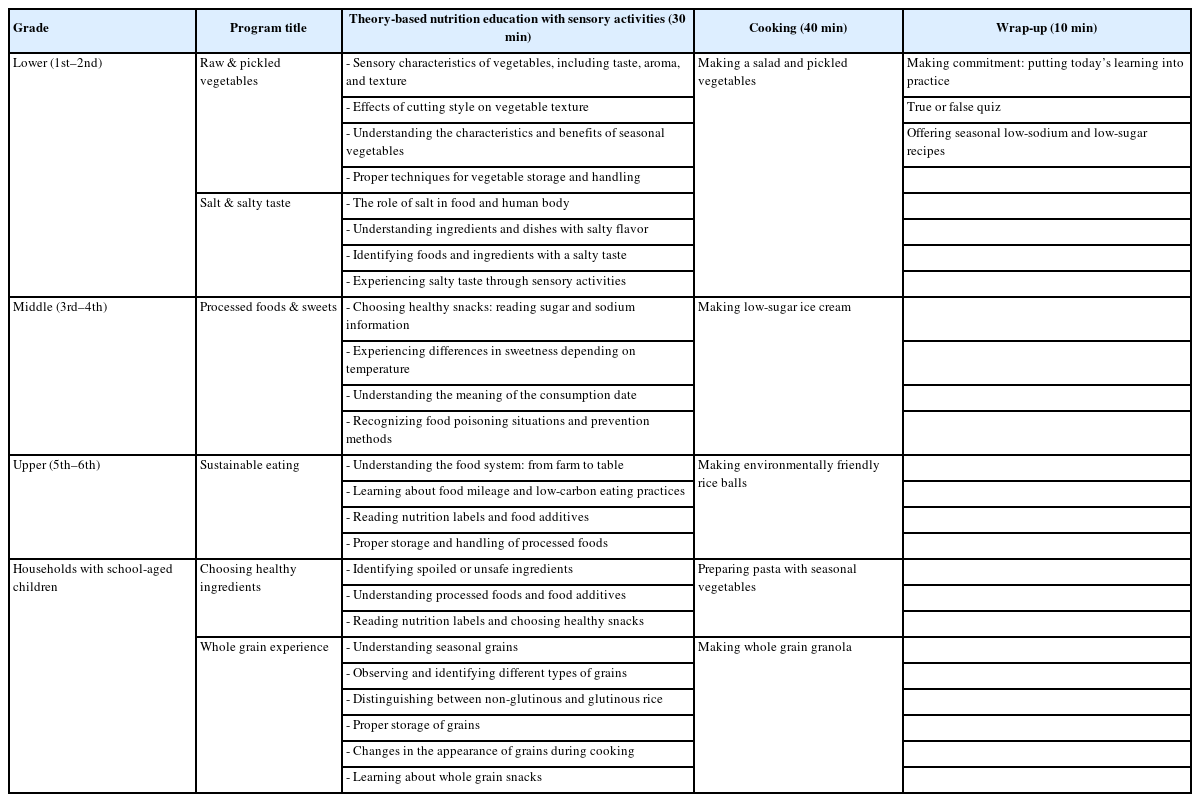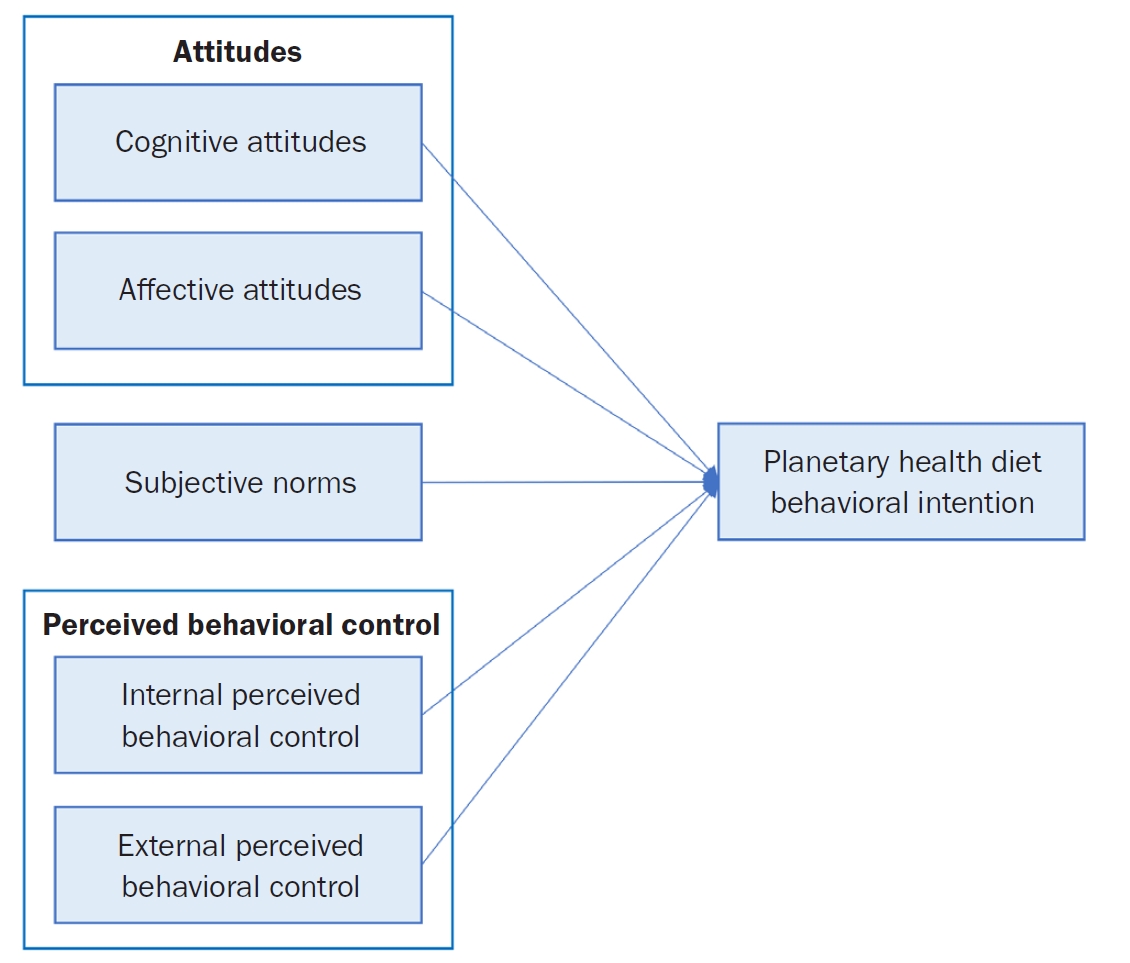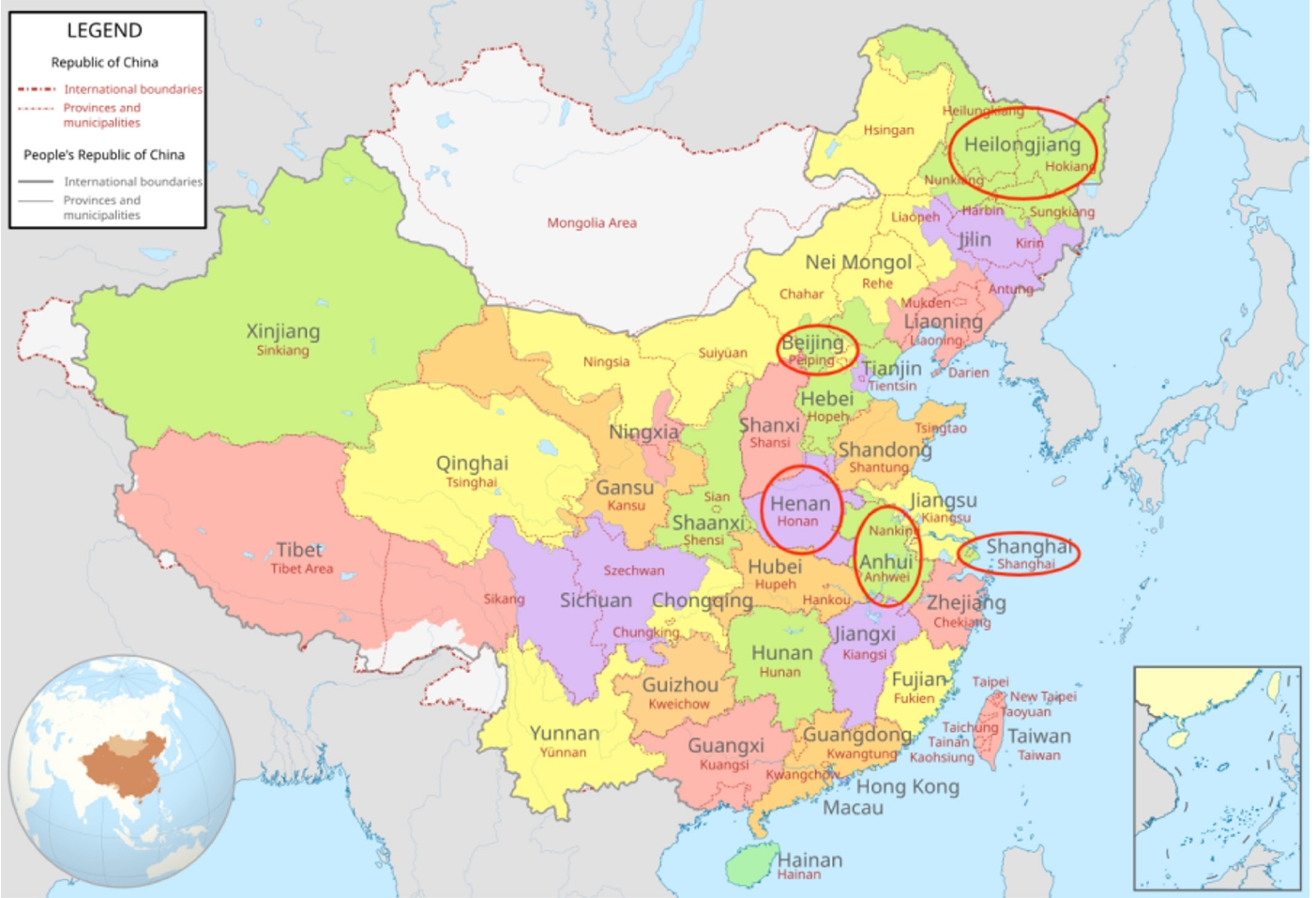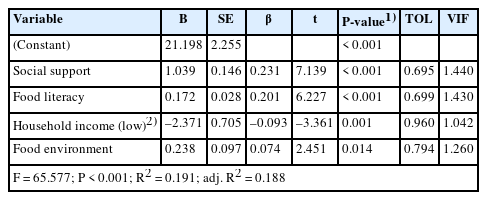- [English]
-
Pilot evaluation of a cooking-based nutrition education program to promote vegetable intake among children in Seoul, South Korea: a single-group pre–post study
-
Sil-Ah Kim, Su-Jin Lee, Min-Ah Kim, Ji-Eun Oh, Sohyun Park, Hyun-Joo Ryou, Ji-Yun Hwang
-
Korean J Community Nutr 2025;30(4):249-260. Published online August 29, 2025
-
DOI: https://doi.org/10.5720/kjcn.2025.00220
-
-
 Abstract Abstract
 PDF PDF PubReader PubReader ePub ePub
- Objectives
Food neophobia in children is often associated with limited exposure and familiarity to some foods. Cooking-based nutrition education (CBNE), which promotes acceptance through direct experience, may support the development of healthy eating habits. This study aimed to develop and implement a standardized CBNE program for school-aged children in Seoul, South Korea, and to evaluate its effectiveness by assessing changes in raw vegetable intake. Raw vegetable intake is an early indicator of the effectiveness of nutrition education on diverse topics in promoting healthy eating habits.
Methods
A single-group pre–post study was conducted with 37 children aged 6–11 years who participated in a 2-day CBNE program in October 2023. The participants completed pre- and post-education questionnaires and raw vegetable intake assessments. Four low-preference vegetables (bell pepper, carrot, cucumber, and tomato) were selected and served raw (25 g each) before and after the program. Intake changes were analyzed using paired t-tests, and Pearson’s correlation and hierarchical regression analyses were performed to identify predictors.
Results
Total raw vegetable intake significantly increased post-education (P = 0.008), particularly for carrots (P = 0.023). By subgroup, raw vegetable intake significantly increased in girls, upper-grade students, and those who consumed four or more vegetable side dishes per meal. Hierarchical regression analysis revealed that while vegetable preference was initially significant, vegetable-related experiences (β = 0.395, P = 0.026) and diversity of vegetable side dishes per meal (β = 0.403, P = 0.032) were stronger predictors in the final model (adj R2 = 0.333).
Conclusion
The CBNE program may enhance vegetable intake in children. Although preference remained the strongest individual factor, vegetable experience and the diversity of vegetable side dishes per meal had a greater combined effect. These findings underscore the importance of repeated and diverse exposure, not only by supporting previous studies that link such exposure to increased intake but also by suggesting that environmental support may be essential for sustaining healthy eating habits.
- [Korean]
-
Behavioral intention toward planetary health diet among adult users of government worksite cafeterias in Seoul, South Korea: a mixed-methods study based on the theory of planned behavior and focus groups interviews
-
Ji-Won Kang, Su-Jin Lee, Sil-Ah Kim, Ji-Yun Hwang
-
Korean J Community Nutr 2025;30(3):224-236. Published online June 30, 2025
-
DOI: https://doi.org/10.5720/kjcn.2025.00108
-
-
 Abstract Abstract
 PDF PDF PubReader PubReader ePub ePub
- Objectives
To reduce urban carbon emissions, in this study, we aimed to suggest strategies for disseminating the planetary health diet (PHD) guidelines to adult cafeterias in a government worksite in Seoul based on the theory of planned behavior (TPB) and focus group interviews (FGI).
Methods
A total of 132 adults who worked at a government worksite in Seoul and used its cafeteria were included for a TPB-based survey. Factor analyses and multiple regression were used to investigate the relationships between attitude (cognitive•affective), subjective norms, and perceived behavioral control (PBC, internal•external) and the behavioral intention to adopt the PHD. To identify the contextual factors related to PHD dissemination, 14 participants underwent in-depth interviews.
Results
Affective attitudes and PBC (internal•external) constructs of the TPB were significantly related with the intention to adopt PHD: external PBC (β = 0.324, P < 0.001), internal PBC (β = 0.269, P < 0.01), and affective attitudes (β = 0.226, P < 0.05). The FGI results highlighted the insufficiency of simply providing healthy meals to encourage the adoption of PHDs, but that menu development and natural acceptance strategies are needed to increase palatability. In addition, the need for strategies to promote PHDs at an organizational level was identified, as it is directly influenced by the company of partners with whom one dines. Furthermore, users' perceptions of how “Meals for the Planet” are delivered and suggestions for its improvement were also interpreted.
Conclusion
Our results suggest that users' beliefs, convictions, and emotions are important while promoting or educating individuals about sustainable PHDs. Our findings are expected to help local governments or private group cafeterias that wish to introduce PHDs in the future, given the growing importance of environmentally conscious eating.
- [English]
-
Healthy eating intentions among adults in China: a cross-sectional study of northern and southern regions and city tiers based on the theory of planned behavior
-
Yi Jiang, Ji-Yun Hwang
-
Korean J Community Nutr 2025;30(2):114-126. Published online April 29, 2025
-
DOI: https://doi.org/10.5720/kjcn.2025.00087
-
-
 Abstract Abstract
 PDF PDF PubReader PubReader ePub ePub
- Objectives
The theory of planned behavior (TPB) has been widely employed to predict healthy eating intentions. Regional differences may affect dietary habits, health status, and personality traits, whereas variations in urbanization influence accessibility to fresh and healthy food, thereby impacting TPB components. This study aimed to explore whether regional differences between northern and southern China including city-tier development are associated with healthy eating intentions among Chinese adults.
Methods
The study included data from 2,114 Chinese adults aged 19–64 years collected between 2019 and 2023. Participants were categorized by geographic region (north or south) and city-tier status (first-tier or other).
Results
Compared to individuals from northern first-tier cities, those from southern regions exhibited stronger attitudes, perceived behavioral control (PBC), and intention to eat healthily. Participants from other cities in the north had more positive attitudes, subjective norms, PBC, and intentions to participate in healthy eating. Furthermore, residents of southern cities revealed weaker subjective norms than those of cities in the north. The adjusted odds ratio (OR) for compliance with intention to engage in healthy eating was higher among participants from other cities in both the north and south compared to those from northern first-tier cities (northern other cities: OR = 2.43, 95% confidence interval [CI]: 1.49–3.97, P < 0.001; southern other cities: OR = 1.95, 95% CI: 1.08–3.51, P = 0.027). No significant differences existed among the subjects from first-tier cities according to their geographic regions. These trends remained consistent even after including the interaction term between geographic regions and city-tier classification.
Conclusion
These findings underscore the complexity of regional variations influencing dietary intentions and indicate that tailored health promotion strategies should incorporate regional characteristics. Future research should explore underlying factors, including regional cultural influences, to better inform policies and interventions.
-
Citations
Citations to this article as recorded by  - Beyond taste: Unpacking the drivers of plant-based diet adoption
Md. Asaduzzaman Babu
Food and Humanity.2025; 5: 100779. CrossRef
-
952
View
-
23
Download
-
1
Crossref
- [English]
-
Nutrition quotient for preschoolers and key impacting factors in Korea: a cross-sectional study on food literacy, social support, and the food environment of primary caregivers
-
Danbi Gwon, Ji-Yun Hwang, Jieun Oh
-
Korean J Community Nutr 2025;30(1):16-26. Published online February 28, 2025
-
DOI: https://doi.org/10.5720/kjcn.2024.00311
-
-
 Abstract Abstract
 PDF PDF PubReader PubReader ePub ePub
- Objectives
This study evaluated the nutrition quotient for preschoolers (NQ-P) and analyzed the impact of key factors, such as caregivers’ food literacy, social support, and food environment, on the eating habits of preschool children in Korea. This study also sought to provide foundational data for developing tailored nutrition education programs by identifying the nutrition education needs of caregivers.
Methods
This study was conducted among caregivers of preschool children (aged 0–6 years) using an online self-administered survey conducted from August 22 to August 28, 2023. A total of 1,116 survey responses were analyzed. This study assessed children’s NQ-P score, caregivers’ food literacy, social support, food environment, and nutritional education needs. Data were analyzed using SPSS 29.0 (IBM Co.).
Results
The average NQ-P score for preschool children was 52, showing a tendency for the balance score to decrease and the moderation score to increase with age. Children from rural and low-income areas exhibited significantly lower NQ-P scores. Caregivers’ food literacy was higher in urban and higher-income groups. Multiple regression analysis revealed that social support, food literacy, income, and food environment significantly affected children's NQ-P scores. The effectiveness of nutrition education varied based on the income level, with nutrition education on healthy eating being the most preferred topic for preschool children.
Conclusion
This study confirmed that caregivers’ food literacy and social support significantly affected preschool children’s nutritional status. This suggests a need for tailored nutritional education and dietary support policies, particularly for low-income and rural populations.
- [Korean]
-
Program Evaluation using the RE-AIM Framework: A Systematic Review and Application to a Pilot Health Promotion Program for Children
-
Ji-Eun Lee, Jae Eun Shim, Kirang Kim, Jae-Heon Kang, Ji-Yun Hwang
-
Korean J Community Nutr 2022;27(4):296-308. Published online August 31, 2022
-
DOI: https://doi.org/10.5720/kjcn.2022.27.4.296
-
-
 Abstract Abstract
 PDF PDF
- Objectives
This study aimed to develop evaluation criteria for the elementary-school-based health promotion program using the RE-AIM framework and to examine their feasibility.
Methods
Previous evaluation studies on health interventions for elementary-school students using the RE-AIM framework were reviewed systematically to identify appropriate evaluation criteria. A diet and physical activity intervention based on the transtheoretical model was implemented in a pilot study using the “Happy Me” application. The feasibility of using the RE-AIM framework to evaluate it was examined.
Results
The review yielded the following evaluation criteria: “reach,” the ratio of participants out of the total target population; “efficacy/effectiveness,” the difference in outcomes between the intervention and control groups, or between a pre- and post-test; “adoption,” the rate of use of the program and participation in the next stage of the program; “implementation,” the progress on the program components; “maintenance,” the participants’ and teachers’ intention to continue using the program. The pilot study reached 76.6% of the targeted population. The intake of sugar-sweetened beverages decreased (P < 0.0001), and the duration of walking increased (P < 0.0001). Other indicators could not be evaluated; therefore, potential indicators were suggested.
Conclusions
This study produced feasible evaluation criteria for elementary-school-based health promotion using the RE-AIM framework. Nevertheless, the feasibility needs to be validated with a broader range of studies and long-term interventions.
- [Korean]
-
Basic Concepts and Detailed Dimensions of Food Security and Related Indicators for Policy Development and Evaluation
-
Sohyun Park, Ji-Yun Hwang, Jae Eun Shim, Kirang Kim
-
Korean J Community Nutr 2021;26(6):429-440. Published online December 31, 2021
-
DOI: https://doi.org/10.5720/kjcn.2021.26.6.429
-
-
 Abstract Abstract
 PDF PDF
- Objectives
Standardized guidelines and reference points for a food security policy are necessary to guarantee that basic social safety nets work properly. Therefore, this study aimed to explore the basic concepts and detailed dimensions of food security, including the potential relevant indicators, and sought to establish standardized well-being baselines.
Methods
A literature review and 14 expert roundtable discussions were carried out to analyze and extract the key concepts of food security. After determining these concepts and detailed dimensions of food security, a conceptual framework was modeled. Then, indicators for each local government that could be monitored and evaluated for each sub-area were suggested.
Results
The concept of food security was defined as follows: Individuals should be provided with sufficient, safe, and quality food, which should be accessible to the community and available for use to achieve health and well-being. In addition, food security should be ensured sustainably in a changing environment. Four dimensions were suggested while conceptualizing food security. First, sufficient food, which means sufficient food supply in quantity, quality, and safety. Second, equitable food which includes creating environments in which high-quality and safe food can be purchased at an appropriate price and can be provided regardless of the socioeconomic gap. Third, healthy food which should be provided to promote people’s health and happiness through the eco-friendly consumption of food.
Fourth, sustainable food, which can be supplied in a sustainable manner and as part of an eco-friendly food system that considers the conservation of natural environments.
Conclusions
The basic concepts and detailed areas of food security including the potential indicators proposed in this study, may be useful for developing and implementing various policies and programs to support food and nutrition security in the future.
-
Citations
Citations to this article as recorded by  - Achieving National Food Security in Sub‐Saharan African Countries: The Role of Foreign Agricultural Aid
Mehmet Balcilar, Godwin Olasehinde‐Williams, Berkan Tokar
Food and Energy Security.2025;[Epub] CrossRef - Prediction model for identifying a high-risk group for food insecurity among elderly South Koreans
Myeunghee Han
Scientific Reports.2025;[Epub] CrossRef
-
968
View
-
19
Download
-
2
Crossref
|




















